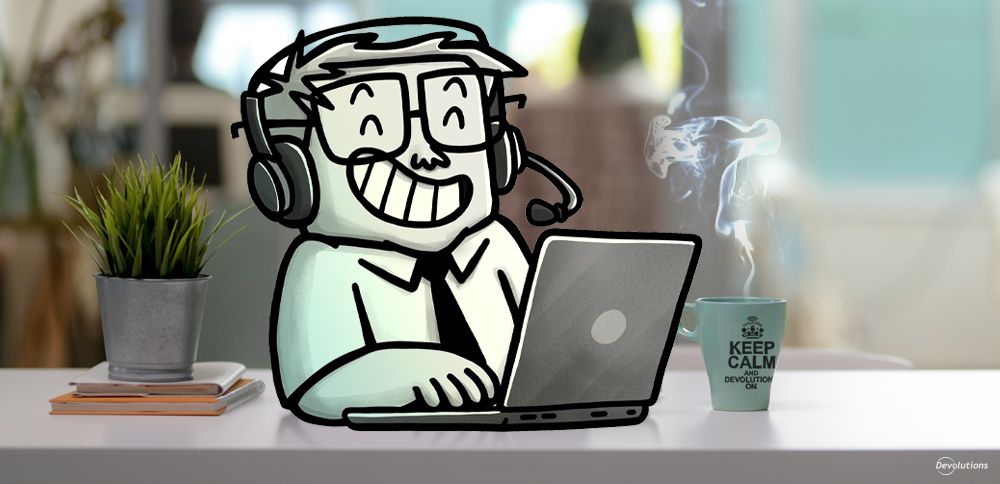Hello, everyone! As a member of Devolutions’ Technical Support Team, I help our customers solve their issues, achieve their objectives, and get the most value from our solutions. It’s a very interesting experience! And speaking of which…
A short while ago, I had a very interesting experience that inspired this blog post! Here’s the story:
I was speaking with a customer who started working in IT about a year ago. He works at a Help Desk and uses Remote Desktop Manager to provide remote support. It didn’t take long to answer his technical questions and resolve his issues. He was happy, which meant that I was happy!
However, before wrapping things up, he asked me something that I’d never been asked before in my many years of providing support. He thought I did a good job, and he wanted me to share some advice on how to deliver great support and streamline your workflow with a remote desktop management solution.
Gandalf Jeff the Grey
I guess he somewhat saw me as a mentor of sorts, which was quite flattering (and yes, made me feel old, but in a good way — like Gandalf!). I also admired this individual for taking the initiative. We can learn SO MUCH in life — and often from people whom we’ve only just met — if we humbly ask questions, and have an open mind.
So now, the pressure was on! I wanted to be helpful, and make sure that I really shared some advice that was both proven and practical. I mean, if 10 years from now this individual became the CEO of some Silicon Valley unicorn and were giving an interview on Bloomberg, I would want him to say something like, “I owe my incredible success to some technical support geek whom I chatted with back in 2023… I forget his name though… I wanna say Jeff?”
7 Best Practices: From Empathy to Documentation
Of course, I’m just kidding — well, mostly kidding. I did seriously, and sincerely, want to be as useful as possible. So, I thought about what I would have really benefitted from knowing when I started my technical support career. I ended up passing along these seven “best practices” which I would like to share with all of you:
-
Always put yourself in your customers’ shoes, so that you can better understand their issues, challenges, and objectives. The better you can identify with your customers, the more clearly you will understand how you can help them.
-
Always ask probing-type questions to pinpoint the issue(s). Sometimes, IT pros — and I am including myself here! — can focus so much on providing solutions, that we don’t fully understand the root problems. Or, in some cases, the customers themselves don’t fully understand. Asking precise, logical questions (and in a polite and friendly way, of course) can really help customers grasp the full picture. This makes THEM more efficient, which will make YOU more efficient!
-
If customers run into an error message, then instead of asking them to explain what they are seeing, simply have them send it to you. Not only does this save time, but it avoids any misunderstandings or miscommunications.
-
Whenever it is practical to do so — and it often is in technical support — do a screenshare and ask customers to take the EXACT SAME steps to reproduce their issue. Why is EXACT SAME emphasized here? Because as many of us know, even very slight deviations in a workflow can lead to vastly different results and outcomes.
-
NEVER — and I mean NEVER EVER — delete something as part of your troubleshooting (or for any other reason). If this means that it takes you longer to resolve an issue, then that is the price to pay. Data loss must be avoided at all costs!
-
Be organized! This will help you deliver faster, better support, and make your life much easier. This is where a tool like RDM comes in handy, because it centralizes sessions and credentials — ensuring that you’re not rummaging for them and panicking when you can’t find them.
-
Document absolutely everything. Yes, I know: we are all so busy, and documenting everything takes time and is a little tedious. But do it anyway! It makes sharing information with your team much easier, and it also helps ensure that customers do not “misremember” their support experience at a later date. For example, if you spent 30 minutes walking a customer through a detailed process, then you definitely want to document this just in case they reach out again down the road and don’t recall the training (I’m not saying that customers are deceptive, but we are all human and we forget things sometimes!).
The Final Word
If you’re new to the world of IT support — or even if you’re a seasoned expert who has been providing support for decades — I hope that you find these best practices valuable. Providing customer support can be difficult and stressful at times. But it is also often challenging and rewarding. There is always something new to learn, and there are many interesting people to meet — including those who inspire blog posts like this one!
Now, if you will excuse me, since I am now a CERTIFIED MENTOR I must go and add this to my bio and email signature, and perhaps I’ll go see what kind of Gandalf hats and robes Amazon has available…




